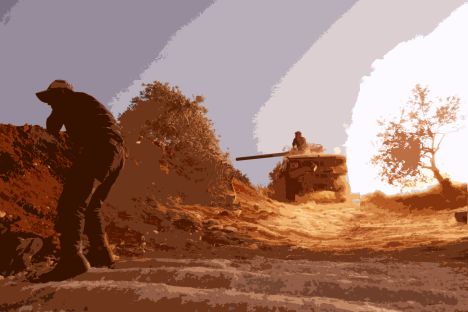
In the last two years, the Islamic State (ISIS) radical militant group has swept through the Middle East, conquering large parts of Iraq and Syria in spite of the attempts of government forces to halt its advance.
Yet ISIS has turned out to be extremely vulnerable in terms of supplies, despite its substantial financial potential, created mainly thanks to sales of contraband oil. Moreover, with its quick expansion north and northwest, the organization has firmly extended its communications.
The following choice of strategic objectives is formed based on an analysis of the ISIS structure, first of all its rear formation, its supplies and the particularities of its tactics.
Thus, for a potential operation against ISIS the most advantageous and important strategic objectives could be the group's rear bases, especially the large fuel and lubricant storage facilities, the frontline repair bases, as well as the columns that supply the fronts with fuel and ammunition.
Currently, the government army already has sufficient air force tools to start successfully carrying out such air strikes. Squadrons (12 units) of front-line Su-24 bombers and the same number of Su-25 attack aircraft are more than enough. This is the quantity of planes, according to certain information, that Russia has recently sent to Syria.
A few weeks of such operations and the supplies of ISIS's frontline units in the province of Idlib, around Aleppo, in the suburbs of Damascus and by Deir ez-Zor will be disrupted.
But for all this time, as is happening now, heavy fighting on the ground will continue in some critical areas. The government forces are now faced with three immediate challenges. The first is to push back ISIS forces and their allies from the eastern suburbs of Damascus. The second is to relieve the Kuweires base near Aleppo. The third is to take full control of the road leading from Damascus to Homs.
The battles in the densely populated eastern suburbs of Damascus assumed the character of a war of extermination about a month ago when government forces unsuccessfully attempted a counterattack. It is precisely this region that can be considered the base for the organization of a general counterattack towards the Palmyra region, which basically could reverse the course of military operations against ISIS in Syria.
Currently, ISIS has accumulated its most capable forces in these neighborhoods, which is why the government forces will be able to attack only if they outnumber the enemy. Presumably, modern types of Russian weapons, such as the T-90, can be supplied precisely to this region.
However, this superiority will not be enough to attack Palmyra in an organized and rapid manner. Between the Damascus and Palmyra suburbs is a barren desert with only a few roads and strategic crossroads. Perhaps the only point of support here is the al-Kartyain oasis. This would be an ideal place for paratroopers to land and cut off the large ISIS forces accumulated in the suburbs of Damascus. Such an operation would be possible only with the possession of landing resources, such as transportation aircraft, helicopters and special armored vehicles.
The Kuweires air force base has been under siege for almost three years, but until recently its garrison could have received supplies. There are grounds to believe that the strengthening of air potential and giving Aleppo more modern armored vehicles will finally create an opportunity to relieve the base, which in turn will help the government forces to start pushing ISIS out into the desert.
The strategic Damascus-Homs route is currently severed at two points. And although it is still possible to go around the first problematic point (a detour of about three kilometers), at the second point ISIS has captured several dominant high areas. Driving ISIS out of those places without the use of artillery and helicopters is very difficult and will involve substantial losses.
Originally published in Russian in Vzglyad.
All rights reserved by Rossiyskaya Gazeta.
Subscribe
to our newsletter!
Get the week's best stories straight to your inbox